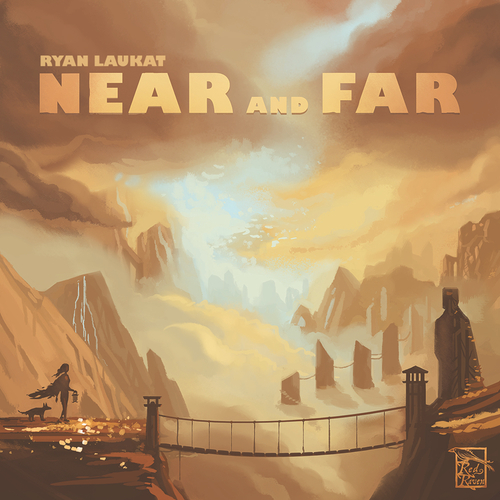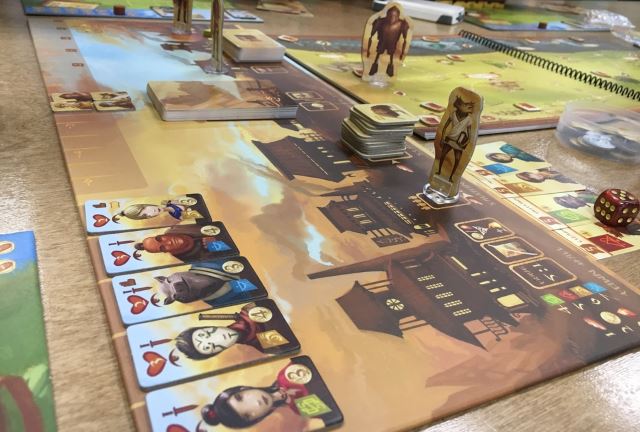
It might be weird, but one of the first things I do when I get hold of a new board game is to inspect the board itself. I love to see where I’ll be playing, what I’ll be staring at for the new couple of hours. They set the scene for the game before you’ve even opened the rulebook or cracked open the components packs. Some of them are crisp and clean for good reason, such as TIME Stories, others are dark and moody like Pandemic: Reign of Cthulhu.
Others, like Near and Far, are books.
Yes indeed. Near and Far isn’t really a board game as such. It’s a cross between an interactive story (think of the awesome Choose Your Own Adventure books from the 80s and 90s) and a voyage of discovery and wonder. The book – called an atlas – provides several maps for your intrepid adventurer to explore in various game modes. The campaign is where the hardcore adventurers will be spending their time, letting you follow the story throughout the entire series of maps and giving you the chance to level up your character, carry out various additional missions and see the story change as a result of decisions you’ve been making along the way. A full campaign will take you many, many hours but possibilities are numerous, with decisions taken along the way affecting what happens later and opening up whole new possibilities in terms of how the story pans out.
There’s also a Character Mode, offering a similar experience to the full campaign but using fewer maps, while still allowing you to build up your character’s personality and maintaining your various advancements that you pick up along the way. It’s a great way to build up a character without committing to a full campaign, but is still relatively deep when you compare it to the Arcade mode.
It seems weird referring to an Arcade mode in a board game, but here it just means you can spend a couple of hours trying out different maps with simpler rules, very little in terms of character progression and a bigger focus on just enjoying a faster game. There’s even a set of cards specifically for the arcade mode instead of using the larger story book, such is the difference in style between the arcade mode and other ways to play. Given the choice I’d always lean towards the character mode over arcade, but some will definitely like the pick-up-and-play nature of arcade. Just don’t stick solely to it, otherwise you’ll be totally missing the point of Near and Far.

And that issue is really worth highlighting. Near and Far needs commitment to really get the most out of it, to get the most out of the story telling potential, and to fully immerse yourself in the characters that you’ll develop over the course of many gaming sessions. And some might struggle with that, especially as the opening of the game – trying to gather resources around town before setting off – is quite slow going and doesn’t give anything like the best first impression. It’s also, for all intents and purposes, a solo game. Yes there are moments when a duel breaks out between two players but there’s such a small impact from losing a dual that it’s not really a concern, and we ended up actively avoiding it to keep the game’s pace up. Weirdly the various quests that open up throughout the game have a similar affect, in so much as they can’t really end badly, but they felt far more fulfilling than the player vs player encounters. These things don’t mean that Near and Far is a bad game, because it absolutely isn’t, but you won’t be getting a fat lot of interaction between your characters and those of other people.
It’s looking at the game as an overall package that shows its full qualities though. The slower, but spot on, overall pace of the storylines playing out, the way your characters can develop personalities as you make various decisions along the way, and how the various locations open up whole new areas of dialogue and adventure. You can play this at a really nice leisurely pace, chatting about what’s going on, discussing the stupid decision you just made that totally changed your characters overall image. Even afterwards we found ourselves chatting about things that had gone on, laced with dozens of “what if…” questions that made us want to dive back into the atlas and take on a whole new adventure. There’s no reason at all to think that things will be the same next time round, and that desire to see what else the game has to offer is very strong indeed.
So would I recommend Near and Far? Yes. Quickly, and eagerly, but only if you know the limitations before you go into it. Don’t base your experience on the opening 10 minutes. Don’t expect to be interacting with other players in a way that’ll have much effect on proceedings. But by all means go into it expecting some awesome stories to unfold in front of you, and have some lasting memories implanted into you. You won’t be disappointed.

Leave a Reply